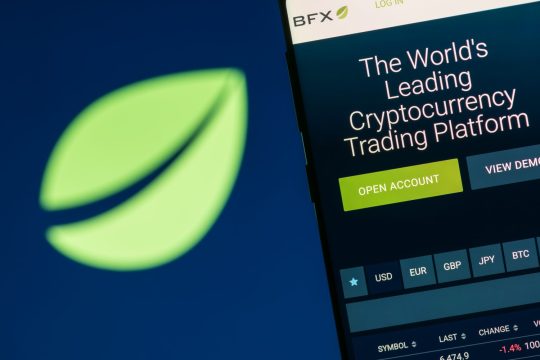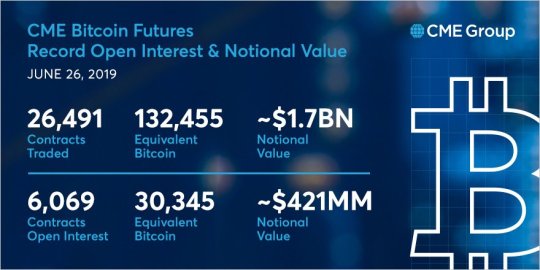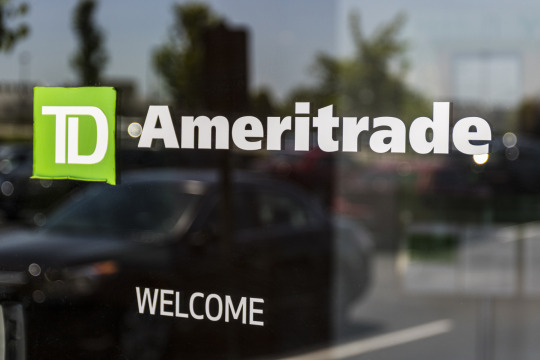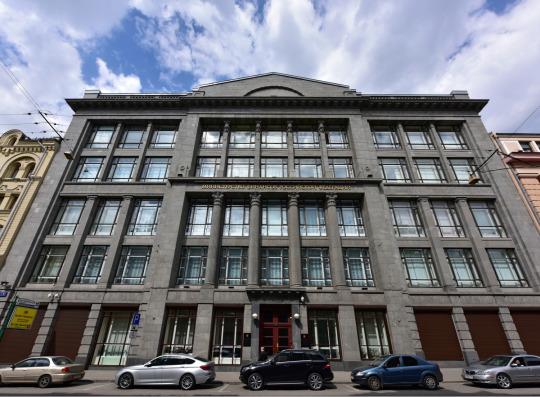Photo

New Post has been published here https://is.gd/jthIxg
Bitfinex Repays Tether $100 Million of $700 Million Loan

This post was originally published here

Crypto exchange Bitfinex said Tuesday that it had begun repaying a loan from its sister company Tether.
Bitfinex borrowed as much as $700 million from the stablecoin issuer through a line of credit in early 2019, according to legal filings by the New York Attorney General (NYAG)’s office. The exchange needed the cash to make up for an $850 million hole which resulted from its payment processor, Crypto Capital, having its funds seized by authorities in three separate nations.
On Tuesday, the exchange said it had transferred $100 million from its account to Tether’s.
“Bitfinex made this payment in fiat wired to Tether’s bank account,” the announcement read. “This amount was not yet due to be paid to Tether under the facility, but Bitfinex has made the prepayment based upon its financial position at the end of the second quarter of 2019.”
“Also on July 1st, Bitfinex fully prepaid all interest accrued under the loan facility to Tether up to the end of day on June 30, 2019, also in fiat,” the exchange added.
Bitfinex and Tether have long shared key executives and shareholders, though both companies maintain that they are distinct entities. Tether’s USDT token, which usually trades around $1, is supposed to be backed 1-for-1 with U.S. dollars or cash equivalents, but the Bitfinex loan meant a portion of that collateral was replaced with the debt of an affiliated company.
Legal battle
IFinex, Bitfinex’s parent firm, and other affiliated entities are embroiled in a legal fight with the NYAG’s office over the alleged cover-up of its $850 million loss.
The company has filed a motion to dismiss, claiming that the NYAG has neither the jurisdiction nor sufficient evidence to back up its claims.
The NYAG’s office has until July 8 to file its opposition, and iFinex and its affiliated companies will be able to file their own response by July 22.
Attorneys for both sides are due back in court on July 29.
Bitfinex image via Shutterstock
#crypto #cryptocurrency #btc #xrp #litecoin #altcoin #money #currency #finance #news #alts #hodl #coindesk #cointelegraph #dollar #bitcoin View the website
New Post has been published here https://is.gd/jthIxg
0 notes
Photo

New Post has been published here https://is.gd/GBhA2U
CloudFlare Outage Takes Down Coinbase, CoinMarketCap and Other Top Crypto Websites
This post was originally published here
A brief outage Tuesday morning at 10:00AM Eastern took down a number of crypto information and trading sites including Coinbase and CoinMarketCap. The issues cleared up around 10:18AM and most sites seem to be running again.
Cloudflare, a CDN provider, first noticed the outage at 1:52PM UTC/9:52 AM Eastern and the impacted sites went down shortly after, wreaking havoc on automatic pricing engines including CoinDesk’s. For a moment CoinDesk’s widget displayed a price of $26 per bitcoin.
Coinbase noticed and implemented a fix after the outage.
Poloniex noted the outage but explained that no funds were lost while Itbit reported that the front-end web server failed by no back-end functions crashed.
Due to technical issues with our of our partners, Poloniex is currently unavailable for trading. We are working with our partner to resolve these issues as quickly as possible. All funds are safe, and we will keep you updated here.
— Poloniex Exchange (@Poloniex) July 2, 2019
The suspected culprit, Cloudflare, is a service used by many websites to speed up delivery of data and media over the Internet.
Bitcoin price hovered at around $10,000 during the outage, falling as far as $9,958 according to CoinMarketCap.
Image via Shutterstock.
#crypto #cryptocurrency #btc #xrp #litecoin #altcoin #money #currency #finance #news #alts #hodl #coindesk #cointelegraph #dollar #bitcoin View the website
New Post has been published here https://is.gd/GBhA2U
0 notes
Photo

New Post has been published here https://is.gd/qyrudF
IOTA Foundation Launches Trinity, a New Software Wallet for IOTA tokens

This post was originally published here

The IOTA Foundation has launched the Trinity wallet, as the organization announced in a press release on July 2.
The announcement advertises the Trinity wallet as an improve to both ease-of-use and security for users conducting transactions in IOTA, with the purported goal of appealing to both new and advanced users.
Reportedly, the wallet’s beta version has seen 160,000 downloads and transactions worth over $1.8 billion of IOTA. Cybersecurity firms SixGen andAccessec audited the application in advance of release.
As a software wallet, Trinity is designed for compatibility with Ledger’s hardware wallets, as Ledger has worked alongside the IOTA Foundation since the end of 2018, as Cointelegraph reported. Other reported features of the new wallet include Keepass-compliant security and encryption, biometric authentication, and availability in 25 languages and on Mac, Windows, Linux, iOS and Android.
The IOTA Foundation is a German non-profit whose distributed ledger technology (DLT) has seen recent partnerships with companies such as Primority for food tracking and Alyx for fashion supply-chain transparency.
IOTA’s DLT is unique in depending upon its Tangle. Rather than a true blockchain, Tangle depends on a directed acyclic graph (DAG) that runs different types of transactions on separate chains simultaneously.
#crypto #cryptocurrency #btc #xrp #litecoin #altcoin #money #currency #finance #news #alts #hodl #coindesk #cointelegraph #dollar #bitcoin View the website
New Post has been published here https://is.gd/qyrudF
0 notes
Photo

New Post has been published here https://is.gd/O39UkV
Blockchain Retains Nominal Role in Cleveland Tech Hub

This post was originally published here

Tower City Center, which was purported to become a blockchain hub in Ohio, is now slated to become an entrepreneurial center.
According to a report by cleveland.com on July 1, the Tower City shopping mall had been struggling financially, and was thought to be receiving an overhaul as a Cleveland-based blockchain center at some point.
However, Blockchain Cleveland member Bernie Moreno says that plans have changed. Moreno commented on the new business plan for Tower City today, saying:
“I started with a mindset that this could be a blockchain hub, and as we got more and more people engaged in the community and heard feedback, we adapted the mission to be much more focused on, what does the community really want?…. It was loud and clear that what they really wanted was a center for entrepreneurship that’s much broader than just tech and a lot broader than just blockchain tech.”
The concept of blockchain will reportedly retain a nominal role in the development of the new entrepreneurial center, the so-dubbed “City Block,” mostly as an eye-catcher to bring in more people to conferences. Moreno remarked on this modest role of blockchain, saying:
“It’s not what we’re going to be leading with, it’s going to be just something we use to attract people to Cleveland for conferences and things like that.”
Blockchain technology has been touted as a way to revitalize the Cleveland area. An area trade group has formed in order to develop the blockchain industry in the area, calling itself The Blockland Initiative.
In December of last year, nonprofit JumpStart CEO Ray Leach announced that a total of seven funds were primed to invest $100 million in Ohio-based blockchain startups.
#crypto #cryptocurrency #btc #xrp #litecoin #altcoin #money #currency #finance #news #alts #hodl #coindesk #cointelegraph #dollar #bitcoin View the website
New Post has been published here https://is.gd/O39UkV
0 notes
Photo

New Post has been published here https://is.gd/6tAeaC
CME Bitcoin Futures Record $1.7 Billion High in Notional Value

This post was originally published here
The Chicago Mercantile Exchange (CME) Group has announced more record-breaking highs for bitcoin (BTC) futures in an official Twitter post on June 28.
The futures in question are standardized contracts that bind a party to buying or selling bitcoin at some set time after signing.
According to the post, CME Bitcoin futures hit $1.7 billion in notional value traded on June 26, a 30% increase from its last recorded high. The open interest for BTC futures now sits at 6,069 contracts, reportedly as a result of institutional interest.

New CME bitcoin futures record. Source: Twitter
A week prior, on June 21, CME bitcoin futures broke $10,000, according to data on TradingView. Just one day prior to that, on June 20, the CME Group posted another record high of 5,311 open futures contracts totalling 26,555 BTC — approximately $280 million at press time.
The value of the cryptocurrency BTC itself is hovering around $10,500 at press time. Bitcoin peaked around $13,800 last week, but failed to hold at $12,000 after temporarily trading sidewise in that range on June 28 and June 29.
As previously reported by Cointelegraph, BTC bull Max Keiser recently predicted that altcoins will go under as investors move heavily from alts to BTC due to its technical superiority. “The altcoin phenomenon is finished,” said Keiser.
#crypto #cryptocurrency #btc #xrp #litecoin #altcoin #money #currency #finance #news #alts #hodl #coindesk #cointelegraph #dollar #bitcoin View the website
New Post has been published here https://is.gd/6tAeaC
0 notes
Photo

New Post has been published here https://is.gd/l04RGr
Longenesis Brings South Korean Medical Records to the Blockchain

This post was originally published here

Longenesis has concluded two new partnerships in South Korea.
According to the Riga, Latvia-based, Hong Kong-incorporated company, it will be providing its medical-consent platform-as-a-service to Hanshin Medipia Medical Center and Infinity Care. That brings to four the number of business relationships it has in South Korea, currently the company’s primary market of focus.
Longenesis, which was formed in late 2017, provides a suite of modular blockchain solutions for medical providers, supplying everything from user interfaces for patient interaction to medical recordkeeping. But its main focus has become medical-consent technologies.
With its platform, every step of the process is linked, verifiable and auditable. The patient agrees to specified care or participation in a study or a trial. They can withdraw that agreement, while the medical provider can offer to extend, modify or amend the agreement.
The key, said Denis Bazinov, Longenesis project manager, is the way in which the system works with pharmaceutical companies and research institutions. They can peruse the anonymous metadata to see what information might be available. They can then offer to the owner of the data—the patient—the opportunity to participate trials or studies or release their existing information to be used in the evaluation of a medicine or procedure.
Bazinov said this is very different from current normal operating procedures. In most cases, consent is handled by using paper forms, and the system for renewing, updating and altering consent is haphazard and inconsistent. Once the data is collected, it is traded in an OTC-like manner, with researchers paying for bulk deliveries of information that may not be reliable or properly collected.
“What our platform offers is a transparent chain from the patient through to the hospital,” Bazinov said. “Our desire is to make more information available to the researchers, who now face problems of quantity and quality.”
Hanshin Medipia, located in Seocho, Seoul, specializes in testing and health checkups. Infinity Care is the developer of a healthcare algorithm.
Longenesis is already active in South Korea and has two previous transactions in the market. In April, it signed an agreement with Incheon-based Gil Medical Center to develop a blockchain solution for medical-data management. The other relationship is with Korea’s Terragene.
The solution being provided by Longenesis utilizes Bitfury’s Exonum, a framework for decentralized blockchain applications. According to Bitfury, the platform is highly secure, transparent and auditable, written using the Rust programing language.
Longenesis has the exclusive license for the use of Exonum in the medical field.
The company notes that the product is Health Insurance Portability and Accountability Act (HIPAA) and General Data Protection Regulation (GDPR) compliant, so it meets both US and EU standards.
Insilico was founded in 2014 and has raised a total of $14.3 million, according to Crunchbase. Bitfury, a cypto mining company, has raised a total of $170 million over a number of funding rounds. Investors include Macquarie Capital. At the end of 2018, valuation was estimated at more than $1 billion.
Bitfury, which is considering an initial public offering this year, already has significant relationships with South Korean partners. Earlier this year, it established Bitcoin mining operations in Paraguay with Commons Foundation, a Seoul-based group. Korelya Capital, which is based in Paris and connected with South Korea’s Naver, was an investor in an $80 million Bitfury funding round late last year.
Image via Shutterstock.
#crypto #cryptocurrency #btc #xrp #litecoin #altcoin #money #currency #finance #news #alts #hodl #coindesk #cointelegraph #dollar #bitcoin View the website
New Post has been published here https://is.gd/l04RGr
0 notes
Photo

New Post has been published here https://is.gd/LvBDua
TD Ameritrade-Backed ErisX Gets Green Light to Settle Futures in Bitcoin

This post was originally published here

The U.S. Commodity Futures Trading Commission (CFTC) has cleared the way for crypto derivatives provider ErisX to offer futures contracts with a new license approval Monday.
ErisX, which is backed by U.S. brokerage TD Ameritrade, announced that the CFTC granted it a derivatives clearing organization (DCO) license, acting as a secondary approval on top of an existing designated contract market (DCM) license that the exchange already held. The approvals mean the company can now launch crypto futures products under the auspices of the U.S. regulator.
While no firm timeline was provided, ErisX’s announcement said it would launch its futures contracts – which would be physically-settled, meaning customers receive real bitcoin and not the cash equivalent – “later this year.”
In a statement, ErisX CEO Thomas Chippas said that the company is “unique” because it “divided the trading and settlement functions using traditional DCM (exchange) and DCO (clearing) models.”
He added:
“This reflects the structure that institutional investors expect from other asset classes and will help drive these markets toward greater relevance and accessibility.”
“Under the DCO order, Eris will be authorized to provide clearing services for fully-collateralized virtual currency futures. Eris’ indirect parent company, Eris Exchange, LLC, is registered with the CFTC as a designated contract market,” a CFTC press release read.
ErisX’s approval comes a week after competitor LedgerX received its own DCM license. Like ErisX, LedgerX has yet to announce a firm timeline for the launch of its bitcoin futures contracts.
Bakkt, the subsidiary of NYSE parent firm ICE, is also planning to launch its own physically-settled bitcoin futures, and is currently waiting on a trust company license from the New York Department of Financial Services.
Seed CX, another crypto derivatives provider in the U.S., hopes to offer forwards contracts in the coming months as well.
No-action relief
On top of its DCO approval, ErisX received no-action relief from the CFTC for certain aspects of its offering.
Companies apply for no-action relief when they believe their product can fit the spirit of the law, but not necessarily the letter. It is up to regulators to determine whether the applicants can fulfill that promise. When no-action letters are granted, the applicants must adhere strictly to the list of requirements laid out within.
Specifically, the CFTC Division of Clearing and Risk granted ErisX relief from aspects of Part 39 of the Code of Federal Regulations Title 17.
The letter details how ErisX’s requirement that customers collateralize all transactions enable the CFTC to grant it relief from various provisions that seek to verify the clearinghouse can cover any losses.
According to the letter, ErisX now has relief from regulations that would require it to: conduct stress testing on its financial resources; maintain liquidity to fulfill its obligations during a one-day settlement cycle; require periodic financial reports from all of its clearing members; conduct individual stress testing on large traders; produce daily reports on margin payments and end-of-day positions; and detail its margin methodology.
Because ErisX does not allow for margin positions, the Division of Clearing and Risk has agreed to provide relief against these different sections of Part 39.
ErisX will also certify its futures contract market participant rules prior to launch.
In a statement, ErisX head of marketing Jessica Darmoni told CoinDesk that “Prior to onboarding FCMs, ErisX must first certify to the CFTC that its FCM rules comply with the CEA and commission rules and provide market participants and CFTC an opportunity to review the rules.”
“We have already begun the work in this regard and look forward to working with the CFTC on these requirements,” she added.
TD Ameritrade image via Shutterstock
#crypto #cryptocurrency #btc #xrp #litecoin #altcoin #money #currency #finance #news #alts #hodl #coindesk #cointelegraph #dollar #bitcoin View the website
New Post has been published here https://is.gd/LvBDua
0 notes
Photo

New Post has been published here https://is.gd/Qvz0ho
Monarch Unveils a Marketplace and Crypto Trading Platform

This post was originally published here

Monarch, a wallet and exchange platform, launched a digital asset marketplace to supports 1,900 separate tokens.
The company also announced a partnership with financial-services provider Ambisafe to create a licensed alternative trading system which will enable investment in tokenized entities. A pre-IPO token for SpaceX, representing private shares of the aerospace company, will be offered on the ATS, according to the company.
The Monarch Marketplace consolidates a number of services including a decentralized wallet, ERC20 exchange, a portfolio tracker, and universal KYC integration on a platform that also enables financial services like credit purchases of cryptocurrency and offers 7.1 percent APR interest on crypto holdings.
Monarch President Robert Beadles hopes his company’s suite of applications will streamline the industry and help consumers cut excessive applications. He said the average cryptocurrency user needs nine applications to manage their digital assets.
“Right now, overly complex processes are preventing cryptocurrencies from going mainstream and allowing people to control their financial lives,” said Roger Ver, CEO of Bitcoin.com, in a statement, who advised on the project.
The platform supports almost all available ERC20 and SLP tokens.
Additionally, consumer safety will be bolstered by reducing potential points of attack, according to Beadles. To that end, the company offers asset transfers between hot and cold wallets and allows users to maintain ownership over their private keys and seeds. The wallet feature is licensed as a broker-dealer and awaiting approval by the SEC and FINRA.
Monarch’s integration of Ambisafe’s Orderbook used to buy, sell, and hold securities on the blockchain is also pending FINRA and SEC approval. The platform will allow early investment access to private launches.
Host of Crypto Beadles on YouTube, Beadles teamed up with former Johnson & Johnson engineer Sneh Bhatt to launch Monarch’s free decentralized wallet and marketplace. The two founders provided seed funding for the project, and are currently conducting a token generation event that ends June 30.
Beadles said the ecosystem’s quarter-million clients – with “a few thousand new downloads every week” – have generated a “soft cap of over $2 million” through using the platform.
“For merchants, Monarch allows companies to accept crypto with an easy-to-use plugin, opening them up to new revenue streams and user bases. For partners, Monarch offers access to Monarch users, partner development services, revenue share, and marketing exposure,” he said.
Eric Ly, co-founder of LinkedIn, David Zimbeck, lead developer at BitBay, and Damon Nam, founder of CoinVest, also serve as advisors.
Digital shopping photo via Shutterstock
#crypto #cryptocurrency #btc #xrp #litecoin #altcoin #money #currency #finance #news #alts #hodl #coindesk #cointelegraph #dollar #bitcoin View the website
New Post has been published here https://is.gd/Qvz0ho
0 notes
Photo

New Post has been published here https://is.gd/cHCcxg
Russia Won’t Ban Facebook’s Libra Currency, Deputy Finance Minister Says

This post was originally published here

The Russian Ministry of Finance will not issue any special regulations for Facebook’s upcoming digital currency Libra, deputy minister Alexei Moisseev said Monday.
Answer reporters’ questions, Moisseev said Libra will be treated in Russia like any other digital asset, regulations for which are coming, according to the news agency Interfax.
He added:
“Nobody is going to ban it. “
On the other hand, no cryptocurrency of any sort will ever become legal tender in Russia, Moisseev said. “The ruble is our national currency and all operations should be conducted using it.”
Rather, cryptocurrencies will have a status similar to foreign currencies. “It will be possible to buy it, sell it, keep it, but not use it [to pay for goods and services],” Moisseev said of crypto. “Yes, the legitimate market should be formed. But it’s out of the question that under the banner of a legitimate market, everything is possible.”
Although it is not the leading social media platform in Russia, Facebook has a significant presence in the world’s ninth most populous country, with a 39 percent market share by one measure.
Facebook’s vision for Libra – a global cryptocurrency backed by a basket of fiat currencies – has riled regulators and politicians worldwide, with the U.S. Congress set to hold hearings this month and the G7 forming a task force to study the project.
Legislation coming
Moisseev also told reporters that many businesspeople were asking about opportunities to conduct transparent initial coin offerings (ICOs) and a new law for it will be ready soon.
Earlier he told news agency RNS that a bill on digital assets, which has been stalled in the Russian parliament since last May, is likely to pass the main, second hearing in a couple of weeks.
“We had a discussion about it lead by [finance minister] Anton Siluanov, there were the deputy prime minister [Maxim] Akimov, the central bank, the law enforcement agencies… All the decisions have been made, we’ll look at the text [of the bill] and, I hope, in two weeks get it on track for the second hearing,” Moisseev said June 18.
A bill on token sales, however, will be discussed separately, he added. There is no official timeline for passing this bill, entitled “on attracting investments using investment platforms.”
Russian Ministry of Finance image via Shutterstock
#crypto #cryptocurrency #btc #xrp #litecoin #altcoin #money #currency #finance #news #alts #hodl #coindesk #cointelegraph #dollar #bitcoin View the website
New Post has been published here https://is.gd/cHCcxg
0 notes
Photo

New Post has been published here https://is.gd/CAs7j3
Huobi Unveils ‘Finance Chain’ For Building Enterprise Blockchains

This post was originally published here

Huobi Group is jointly developing a new public blockchain for decentralized financial (DeFi) services, according to a press release on July 1.
Major global digital asset financial service provider Huobi has partnered with Chinese blockchain startup Nervos enabling companies to deploy their own blockchains, tokenized assets, as well as DeFi services, according to the announcement.
The joint initiative, provisionally called “Huobi Finance Chain,” is targeting enterprises, financial institutions, as well as exchanges, and is set to operate as a regulatory-compliant financial blockchain network.
Specifically, Huobi is planning to enable regulators to access the network and contribute to it as validators. The network will also feature major regulatory tools and requirements including decentralized identifier (DID), Know Your Customer (KYC), and Anti-Money Laundering (AML).
Additionally, the developers expect the project to host lending services, debit services, stablecoins, security token offerings (STOs), as well as “other means of asset issuance,” decentralized exchanges (DEXs), and payment services, Huobi stated in the press release.
Expected to open source in Q3 2019, Huobi Finance Chain is scheduled to be rolled out in testnet launch in Q1, while mainnet launch is planned for Q2 2020.
Founded by a former researcher and developer at the Ethereum Foundation, Nervos Network is a collection of protocols and public blockchain ecosystem. In July 2018, Nervos raised $28 million from major industry firms including Polychain Capital in order to develop its enterprise blockchain solutions.
As recently reported, DeFi platforms are primarily promising in credit and lending services. According to DeFi.Review, EOS REX is the biggest DeFi platform by a comfortable margin, having around $587 million in EOS held in its platform at press time. The project is followed by MakerDAO, lender of its stablecoin DAI, with the deposits accounting for about $446 million to date.
#crypto #cryptocurrency #btc #xrp #litecoin #altcoin #money #currency #finance #news #alts #hodl #coindesk #cointelegraph #dollar #bitcoin View the website
New Post has been published here https://is.gd/CAs7j3
0 notes
Photo

New Post has been published here https://is.gd/75C2pQ
South Korea’s Second Biggest City Wants to Create a Local Cryptocurrency

This post was originally published here

Busan, South Korea’s second most-populous city after Seoul, is considering the launch of a local cryptocurrency, Korean tech news publication ETnews reports July 1.
According to the report, Busan city authorities are seeking to develop a blockchain-based digital currency project in collaboration with BNK Busan Bank, a subsidiary of local holding company BNK Financial Group.
Specifically, Busan is reportedly developing a crypto project in the form of stablecoin, a cryptocurrency pegged 1:1 to the local currency in the BNK Busan bank account. By issuing a local digital currency, Busan expects to revive the local economy, as well as to secure the leading position in blockchain, the report notes.
The news comes amid the upcoming establishment of South Korea’s blockchain regulation-free zone, for which Busan was selected as the preferred bidder along with its competitor Jeju Province, as reported in April 2019. As a part of the potential designation, Busan is reportedly going to promote blockchain tech in multiple industries, as well as to provide a basis for cryptos, particularly including initial coin offerings (ICOs).
In April, South Korea’s Ministry of Small and Medium Businesses (SMEs) and Startups said that the government plans to provide “extensive support if Busan develops its own blockchain-based currency structure or token economy.”
Earlier in February 2019, Busan signed a Memorandum of Understanding (MoU) with blockchain company Hyundai Pay with the purpose of promoting blockchain industry through “contribution to the development of local ICT industry through mutual growth with related start-up businesses.”
Previously, South Korea’s government revealed plans to invest $3.5 million to create a blockchain-enabled virtual power plant in the city of Busan.
Meanwhile, recently, major local commercial lender KB Kookmin Bank signed an agreement with blockchain tech firm Atomrigs Lab to jointly explore digital asset management and protection solutions.
#crypto #cryptocurrency #btc #xrp #litecoin #altcoin #money #currency #finance #news #alts #hodl #coindesk #cointelegraph #dollar #bitcoin View the website
New Post has been published here https://is.gd/75C2pQ
0 notes
Photo

New Post has been published here https://is.gd/PgkVZm
Cryptocurrency Mobile App Downloads Stall Amid Price Surge: Report

This post was originally published here

Despite bitcoin’s (BTC) recent price surge, the download count of cryptocurrency-related mobile applications is not increasing, Bloomberg reports on June 28
Data form mobile app analytics firm App Annie shows that, while in the first half of 2018 there were 65.8 million cryptocurrency-related app downloads, in the first six months of this year there were 67 million, an increase of about 1.82%.
This growth is not nearly as sharp as that reported in previous years, considering that the first half of 2017 saw 28.2 million crypto apps downloads from 2016’s 15.3 million, a 45% increase.
Apps related to the industry were individuated by looking for apps including words like bitcoin, cryptocurrency, or blockchain in their description in the finance category of the Apple App Store or Google Play store. Bloomberg also notes that the number of relevant apps is up 35% from January 2018 and points out that searches for bitcoin are down 73% from the peak registered in December 2017.
The report postulates that low crypto app growth is an indicator of low consumer enthusiasm for the asset class, despite the recent rally. Indeed, recent research from institutional crypto lender Genesis Capital — an affiliate of Genesis Global Trading — indicates that institutional participation in cryptocurrency markets is on the rise, and could be a driver of the recent bull market.
As Cointelegraph reported earlier this week, veteran trader and author Peter Brandt predicted in a recent market forecast that bitcoin will continue to grow, but altcoins will not feel the benefits.
Also this week, Galaxy Digital founder and crypto enthusiast Mike Novogratz predicted that Bitcoin’s price will stabilize between $10,000 and $14,000.
#crypto #cryptocurrency #btc #xrp #litecoin #altcoin #money #currency #finance #news #alts #hodl #coindesk #cointelegraph #dollar #bitcoin View the website
New Post has been published here https://is.gd/PgkVZm
0 notes
Photo

New Post has been published here https://is.gd/KWddiN
Bridging the Gap Between Bitcoin and Global Regulators
This post was originally published here
Shin’ichirio Matsuo is a research scientist in cryptography and information security at Georgetown University and a co-founder of the BSafe.network, a global blockchain research test network used by 25 universities.
Since 2015, when bitcoin became an issue for regulators like the state of New York, the regulation of cryptocurrency (the G20 now calls it as a crypto asset) has been discussed in many places, mainly at bodies like the Financial Stability Board (FSB) and the Financial Action Task Force (FATF).
However, Facebook’s Libra cryptocurrency has changed the landscape, ensuring a massive number of debates on regulation are likely ahead. To be sure, these debates will be about the size of companies specializing in internet technologies more than they are about technology architecture.
Yet, throughout the history of crypto asset and blockchain, regulators have been considered an enemy, even as most governments have sought new financial innovations based on the blockchain.
The main issue is, we still don’t have proper communication channels among stakeholders in this ecosystem. Regulators don’t have a functional language to talk with open-source engineers. Open-source engineers sometimes do not want to speak with regulators.
Business entities wish to use new and immature technologies by avoiding frictions with regulation. Citizens need transparency to business entities, but there are no standard criteria to ensure transparency of business. Generally (and I hope) regulators don’t want to discourage innovation, and open-source engineers don’t want to facilitate crimes. The goals of both are almost the same.
But, to make the situation more productive, we need to solve this communication problem. That is now beginning to happen.
Historical discussion at the G20
On June 8 and 9 of this year, the G20’s financial ministers and central bank governors met in Fukuoka, Japan, bringing together a group of 20 governments that discuss issues related to economics.
The FSB, FATF and the International Organization of Securities Commissions (IOSCO) are the organizations which form regulations under G20 leadership. Before the G20 financial track, the FSB published an insightful report titled “Decentralized financial technologies: Report on financial stability, regulatory and governance implications.”
This report emphasized the importance of multi-stakeholder discussions, and that regulations and laws are not an 100 percent perfect tool for forming a healthy ecosystem. It concluded contributions from all stakeholders, including open-source engineers, are essential.
On June 8, the G20 held “G20 High-level Seminar on Financial Innovation Our Future in the Digital Age” to discuss the issue of multi-stakeholder governance.
This was indeed the genesis block of discussions by different stakeholders, including Klas Knott, the vice-chair of FSB, Brad Karr, managing director of IIF (a world group of established banks), Adam Back, the famous cryptographer and Jun Murai, the famous “Internet Samurai” who developed the first-ever inter-university internet communications network in Japan.
The author pictured with Klas Knott, Brad Karr, Adam Back and Jun Murai.
Knott firstly explained the FSB report and the views of his fellow regulators, including their regulatory goals. He went on to discuss many potential applications of decentralized finance, including financial inclusion. Back explained how blockchain technology is an excellent tool to achieve regulatory goals.
I discussed how multi-stakeholder discussion would facilitate healthy permissionless innovations in decentralized finance. We further agreed that the multi-stakeholder discussion is essential for decentralized finance to be made real.
As a result of this seminar and G20 discussion, the following historical sentence was written in the official communique.
“We welcome the FSB report on decentralized financial technologies, and the possible implications for financial stability, regulation and governance, and how regulators can enhance the dialogue with a wider group of stakeholders.”
What multi-stakeholder governance means
In general, governments tend to keep their right to control everything. The internet, which creates a global space of communication, was the first challenge to this order. Here, “global” is different from “international,” because it is independent from the nation.
The internet is also one of the most successful cases of multi-stakeholder governance.
Even in the case of the internet, the government tried to be the only entity of governance, but the effort failed; governments are one of the stakeholders of Internet Governance Forum (IGF) and Internet Corporation for Assigned Names and Numbers (ICANN).
This structure is an excellent foundation that facilitates a huge amount of permissionless innovation, but is also compliant with regulations. A similar situation will happen in finance, and this is the reason why the FSB and G20 are working toward the communique, through the involvement of multi-stakeholders might imply reducing their power of governance.
Here, stakeholders include open-source developers, regulators, business entities, consumers and academia, who are all seeking to solve the current chaos in terms of regulation and innovation in finance. I think it is good to start with have common understandings of regulatory goals; they are financial stability, consumer protection and preventing crimes.
Multi-stakeholder discussion on these goals will create healthier governance than regulation.
Academia facilitates the dialogue
Unfortunately, communications among stakeholders are not sufficient at this moment. However, we need more calm dialogue based on shared understandings and based on academically reviewed pieces of evidence.
One piece of good news is there are several existing initiatives which facilitate discussions among stakeholders. The Scaling Bitcoin workshop was established in 2015 to create a forum for technology discussions led by academics. Likewise, regulators today discuss their work with academics and economists.
Financial innovation workshop at this year’s G20.
This in mind, I believe academia can serve as a good trust anchor and neutral foundation to connect all stakeholder in one place.
A group of universities (currently 31 universities from 14 countries) called BSafe.network has started a new initiative to facilitate multi-stakeholder discussions based on its global neutrality. Right after the G20 financial track meeting, BSafe.network held a multi-stakeholder workshop “G20 meets G-20” with the University of British Columbia. It was the first event of a preliminary series of multi-stakeholder discussions.
A similar workshop, “Decentralized Financial Architecture Workshop,” will be co-located with Scaling Bitcoin 2019 Tel-Aviv, and we hope to see real engagement between regulators and bitcoin engineers.
Observing the current debates on Facebook’s Libra, I conclude we need more moderated and academia-backed discussions to make innovations healthier. The fact is, the Libra Association does not explain how their architecture achieves regulatory goals. Common understandings on regulatory goals and architecture among all stakeholders are essential to start a regulation discussion.
This is a good test case to apply the multi-stakeholder governance.
It may be more difficult than the case of internet governance to establish a formal body for multi-stakeholder discussion on finance. It might take more than a year. However, I believe the historical message triggered by the G20 and a series of workshops will open the door to a new era of a healthy blockchain ecosystem.
Bridge image via Shutterstock
#crypto #cryptocurrency #btc #xrp #litecoin #altcoin #money #currency #finance #news #alts #hodl #coindesk #cointelegraph #dollar #bitcoin View the website
New Post has been published here https://is.gd/KWddiN
0 notes
Photo

New Post has been published here https://is.gd/hW6l4l
Monero and Zcash Conferences Showcase Their Differences (And Links)

This post was originally published here

Last weekend, two privacy coin conferences heralded the future of cryptocurrency governance: the hybrid startup model versus grassroots experimentation.
Over 200 people gathered in Croatia for Zcon1, organized by the nonprofit Zcash Foundation, while roughly 75 attendees gathered in Denver for the first Monero Konferenco. These two privacy coins are fundamentally different in a variety of ways on clear display at their respective events.
Zcon1 had a gala dinner with a seaside backdrop and programming that displayed close relations between companies like Facebook and the zcash-centric startup Electronic Coin Company (ECC), as evidenced by Libra being widely discussed with team members in attendance.
The quintessential funding source that distinguishes zcash, called the founder’s reward, became the center of passionate debates during Zcon1.
This funding source is the crux of distinction between zcash and projects like monero or bitcoin.
Zcash was designed to automatically siphon off a portion of miners’ profits for creators, including ECC CEO Zooko Wilcox. So far, this funding has been donated to create the independent Zcash Foundation, and support ECC contributions to protocol development, marketing campaigns, exchange listings and corporate partnerships.
This automated distribution was scheduled to end in 2020, but Wilcox said last Sunday he would support a “community” decision to extend that funding source. He warned that otherwise ECC might be forced to seek revenue by focusing on other projects and services.
Zcash Foundation director Josh Cincinnati told CoinDesk the non-profit has enough runway to continue operations for at least another three years. However, in a forum post Cincinnati also warned the non-profit shouldn’t become a single gateway for funding distribution.
The amount of trust zcash users place in the asset’s founders and their various organizations is the primary criticism levied against zcash. Paul Shapiro, CEO of the crypto wallet startup MyMonero, told CoinDesk he’s not convinced that zcash upholds the same cypherpunk ideals as monero.
“Basically you have collective decisions instead of individual, autonomous participation,” Shapiro said. “There’s been perhaps not enough discussion about the potential conflicts of interest in the [zcash] governance model.”
While the simultaneous monero conference was much smaller and slightly more focused on code than governance, there was significant overlap. On Sunday, both conferences hosted a joint panel via webcam where speakers and moderators discussed the future of government surveillance and privacy tech.
The future of privacy coins may rely on such cross-pollination, but only if these disparate groups can learn to work together.
Shared zk-SNARKs
One of the speakers from the joint panel, Monero Research Lab contributor Sarang Noether, told CoinDesk he doesn’t see privacy coin development as a “zero-sum game.”
Indeed, the Zcash Foundation donated almost 20 percent of the funding for the Monero Konferenco. This donation, and the joint privacy tech panel, could be seen as a harbinger of cooperation between these seemingly rival projects. Cincinnati told CoinDesk he hopes to see much more collaborative programming, research, and mutual funding in the future.
“In my view, there is a lot more about what connects these communities than what divides us,” Cincinnati said.
Both projects want to use cryptography techniques for zero-knowledge proofs, in particular a variant called zk-SNARKs. However, as with any open-source project, there are always trade-offs.
Monero relies on ring signatures, which mix small groups of transactions to help obfuscate individuals. This isn’t ideal because the best way to get lost in a crowd is for the crowd to be much bigger than ring signatures can offer.
Meanwhile, the zcash setup gave the founders data often called “toxic waste,” because the founding participants could theoretically exploit the software that determines what makes a zcash transaction valid. Peter Todd, an independent blockchain consultant who helped establish this system, has since been an adamant critic of this model.
In short, zcash fans prefer the hybrid startup model for these experiments and monero fans prefer a completely grassroots model as they tinker with ring signatures and research trustless zk-SNARK replacements.
“Monero researchers and the Zcash Foundation have a good working relationship. As for how the foundation began and where they’re going, I can’t really speak to that,” Noether said. “One of the written or unwritten rules of monero is you shouldn’t have to trust someone.”
Shapiro added:
“If certain people are dictating large aspects of the direction of the cryptocurrency project then it raises the question: What is the difference between that and fiat money?”
Different strokes
Stepping back, the long-standing beef between monero and zcash fans is the Biggie vs. Tupac divide of the cryptocurrency world.
For example, former ECC consultant Andrew Miller, current president of the Zcash Foundation, co-authored a paper in 2017 about a vulnerability in monero’s anonymity system. Subsequent Twitter feuds revealed monero fans, like entrepreneur Riccardo “Fluffypony” Spagni, were upset by how the publication was handled.
Spagni, Noether, and Shapiro all told CoinDesk there are ample opportunities for cooperative research. Yet so far most mutually beneficial work is conducted independently, in part because the source of funding remains a point of contention.
Wilcox told CoinDesk the zcash ecosystem will continue to move toward “more decentralization, but not too far and not too fast.” After all, this hybrid structure enabled funding for fast growth compared to other blockchains, including the incumbent monero.
“I believe something not too centralized and not too decentralized is what’s best for now,” Wilcox said. “Things like education, promoting adoption worldwide, talking with regulators, that’s the stuff that I think a certain amount of centralization and decentralization are both right.”
Some fans of both projects see the benefits of that collective approach. Zaki Manian, head of research at the Cosmos-centric startup Tendermint, told CoinDesk this model has more in common with bitcoin than some critics care to admit.
“I am a big proponent of chain sovereignty, and a big point of chain sovereignty is that the stake holders in the chain should be able to act collectively in their own interests,” Manian said.
For example, Manian pointed out the wealthy benefactors behind Chaincode Labs fund a significant portion of the work that goes into Bitcoin Core. He added:
“Ultimately, I would prefer if protocol evolution was mostly funded by the consent of token holders rather than by investors.”
Researchers on all sides acknowledged their favorite crypto would require significant updates in order to deserve the title “privacy coin.” Perhaps the joint conference panel, and Zcash Foundation grants for independent research, could inspire such cooperation across party lines.
“They’re all moving in the same direction,” Wilcox said about zk-SNARKs. “We’re both trying to find something that has both the larger privacy set and no toxic waste.”
Zcash image via Shutterstock
#crypto #cryptocurrency #btc #xrp #litecoin #altcoin #money #currency #finance #news #alts #hodl #coindesk #cointelegraph #dollar #bitcoin View the website
New Post has been published here https://is.gd/hW6l4l
0 notes
Photo

New Post has been published here https://is.gd/k0PU3i
A Partner at Binance Labs Expresses Optimism Over Facebook’s Entry Into Crypto With Libra

This post was originally published here

Speaking to Cointelegraph at Blockchain Week Rome, Teck Chei, partner at Binance Labs, said that he sees Facebook’s Libra Project at a step forward for crypto and increasing public awareness.
In Chei’s own words:
“I think having a company like Facebook, with such tremendous reach and distribution, into all different countries around the world – having them be interested in cryptocurrency and launching one is a very very positive thing for our industry. It brings a ton of awareness to people who have never heard of cryptocurrency.”
Binance is one of the largest cryptocurrency exchanges in the world at present. Binance Labs are the company’s venture arm.
Regarding concerns over Facebook’s use of crypto representing a step towards centralization, Chei remarked that they are one of 100 founders of Project Libra.
Binance and Facebook will be able to work together, Chei predicted:
“We naturally will engage with Facebook to kind of see how we can help advance the industry together.”
Facebook’s Libra project has been subject to no small amount of criticism, both from governments suspicious of Facebook’s data use and from die-hard crypto followers concerned about centralization.
In the United States, Libra will be the subject of Congressional hearings in July over concerns that Libra cryptocurrency will pose a threat to security. After briefings on the subject last week, Representative Emanuel Cleaver II reportedly commented that
“We’ve seen the significant damage that foreign adversaries and bad actors have wrought on our democracy through Facebook’s platform, and that was simply through messaging and advertising.”
Chei’s commentary comes on the heels of Gin Chao’s statement that Binance was engaged in official discussions with Facebook, as Cointelegraph reported on June 28. Chao said that Binance was “looking forward to working with libra as much as we can.”
Earlier in June, Binance announced that the exchange would stop serving clients based in the United States in September as they configure a U.S.-dedicated platform.
#crypto #cryptocurrency #btc #xrp #litecoin #altcoin #money #currency #finance #news #alts #hodl #coindesk #cointelegraph #dollar #bitcoin View the website
New Post has been published here https://is.gd/k0PU3i
0 notes
Photo

New Post has been published here https://is.gd/5RKBrs
Daily Ethereum Transactions Exceed One Million, a First Since May 2018

This post was originally published here

Daily transactions registered on the Ethereum (ETH) network exceeded one million yesterday, June 28, for the first time since May 2018, according to data reported by leading Ethereum block explorer Etherscan.
Per Etherscan data, on June 28 there were 1,004,170 transactions confirmed on the Ethereum blockchain. Before yesterday, the last time the Ethereum chain registered over one million daily transactions was in May 2018. Nonetheless, the current level is still notably lower than the 1,349,890 daily transactions peak registered on January 4 last year.
The on-chain transaction value of Ethereum hit a monthly transaction high in December 2018. That month saw 115 million transactions confirmed on-chain, an all-time high excluding activity following a hard fork caused by the DAO hack in 2016.
As crypto analytics firm Diar reported at the time, Ethereum volumes on decentralized applications (DApps) registered a new high in April with 776,000 ETH transacted. At the end of April, industry newsletter Diar also noted that on-chain transactions on the bitcoin (BTC) network hit fresh highs not seen since 2017 during the month.
Veteran trader and author Peter Brandt predicted in a new market forecast that Bitcoin (BTC) will continue to grow, but altcoins like Ethereum will not feel the benefits.
#crypto #cryptocurrency #btc #xrp #litecoin #altcoin #money #currency #finance #news #alts #hodl #coindesk #cointelegraph #dollar #bitcoin View the website
New Post has been published here https://is.gd/5RKBrs
0 notes
Photo

New Post has been published here https://is.gd/wk6G9o
Facebook’s Libra Crypto Code Draws Critiques and Clones

This post was originally published here

The early-access code for Facebook’s Libra cryptocurrency hit GitHub two weeks ago — and in that time, critics and would-be trollers have taken aim at the project.
Spun-up by the social media giant and presently managed by the non-profit Libra Association, the project on GitHub has been saved or “starred” by close to 10,000 users, signifying an early wave of interest among open-source participants. Additionally, over 1,000 clones of the codebase have been created thus far as would-be coders sit down to experiment with Libra’s code.
In fact, some of those playing with the code have moved to add features previously found in systems like bitcoin, such as open network access for block validators.
Some of these efforts, though, aren’t meant to be wholly serious efforts. Mikko Ohtamaa, who created a so-called “Libra Classic,” told CoinDesk in interview that the effort was “a complete troll” and meant to be taken as a joke.
To this point, Albert Castellana, chief product officer at cryptocurrency startup Radix DLT, remarked:
“There have been no real code flaws submitted so far, mostly build issues or typos, and then some critics pointing out that this is not a decentralized solution.”
Envisioned to support a new global financial payments system, Libra is designed such that at launch a group of 28 founding members will be responsible for validating transactions and appending new blocks — at least at first, with Facebook expressing hope that the network will grow to be more decentralized over time.
In comparison, the original bitcoin network – also designed to be a global financial payments system – enables any individual with computational resources to take part in the never-ending process of creating and broadcasting blocks of transactions (and earning fresh bitcoins in the process).
For this reason, several community members in the cryptocurrency space have directly criticized the permissioned structure of the Libra blockchain not just on social media but on GitHub by nitpicking through every detail of the Libra code.
To troll a social media behemoth
On GitHub, any user with read permissions to a code repository can create issues and pull requests.
Issues, as the name suggests, tag problems in code or areas in need of enhancement. Pull requests, on the other hand, suggest changes to a code repository that reviewers with write or admin permissions can either approve or reject.
Over the past four days, roughly 160 issues have been flagged with the Libra codebase. Over 100 of them have been closed by authenticated users of the codebase, with a handful of these additionally marked as “off-topic.”
While there have been only half as many pull requests to the Libra code repository, some of these reinforce the sentiment shared by those in the cryptocurrency community who believe permissioned blockchain protocols are inherently flawed.
GitHub user “gazhayes” opened up a pull request Tuesday writing:
“I’ve discovered an alarming vulnerability, but fortunately there’s a really simple fix…This problem can easily be solved by using a permissionless system where the hard power is decentralized across a very large number of participants.”
The pull request was closed and the resulting conversation was marked off topic on Wednesday by the official Libra GitHub administrator, which led to complaints by those who deemed gazhayes’ post as a legitimate remark.
“By locking [pull request] #83, it indicated that the maintainers are not open to differing viewpoints and experiences,” wrote decentralized application developer Marcus Newton about the matter.
In response, Ben Maurer, tech lead for Calibra – a subdivision within Facebook dedicated to building a wallet application for the Libra blockchain – insisted:
“We’re really cognizant of the fact that this is a transformative effort and that we need to build a community around it,” Maurer wrote. “But having discourse doesn’t mean the lack of moderation. Off-topic conversations detract from fruitful ones. The thread on #83 was not productive and would have tied up moderation resources.”
Questions remain
Agreeing with this sentiment, Ohtamaa noted that the real efficacy of open-source collaboration on GitHub for the Libra project remains to be seen.
“People just hate Facebook so much that they’re trolling the GitHub [repository].” said Ohtamaa. “All the comments [right now], it’s not a discussion, just angry arguments.”
But with time, Ohtamaa is adamant that with further code specifications further contextualizing how the Libra network will function, the haters will have “no room for argument.”
“From now on, the development will happen in open,” insisted Ohtamaa. “It was basically a code dump but now they are … letting everybody else in and Facebook has a very good reputation when it comes to open source projects.”
Still, by all appearances, there remain unanswered questions surrounding the code that will underpin Facebook’s ambitious project.
Jameson Lopp, CTO of crypto security startup Casa, told CoinDesk in an email that “there’s still a lot of missing information regarding the Move language.”
“There’s also a big question around whether or not people who are not validators will be able to run nodes that download all of the ledger states and check them,” he said. “There are also questions around whether or not that ‘replica node’ mode of operation will also be able to download the blocks created by validators.”
Speaking to some of the immediate next steps for the now open-sourced project, Alexandru Voica, communications manager at Facebook, told CoinDesk:
“One specific thing we can share is that we plan to add a new command line interface for the Move language that should allow a developer to more easily play with the Move language in their own development environment.”
Aron van Ammers, CTO and co-founder of Outlier Ventures, contended that it’s still early for the project and that the coming months should be illuminating.
“It’s so early. Nobody has seen this outside of the Libra, Calibra, and Facebook team before,” said van Ammers, adding:
“It takes time to get started with things like this.”
Image via TY Lim / Shutterstock.com
#crypto #cryptocurrency #btc #xrp #litecoin #altcoin #money #currency #finance #news #alts #hodl #coindesk #cointelegraph #dollar #bitcoin View the website
New Post has been published here https://is.gd/wk6G9o
0 notes